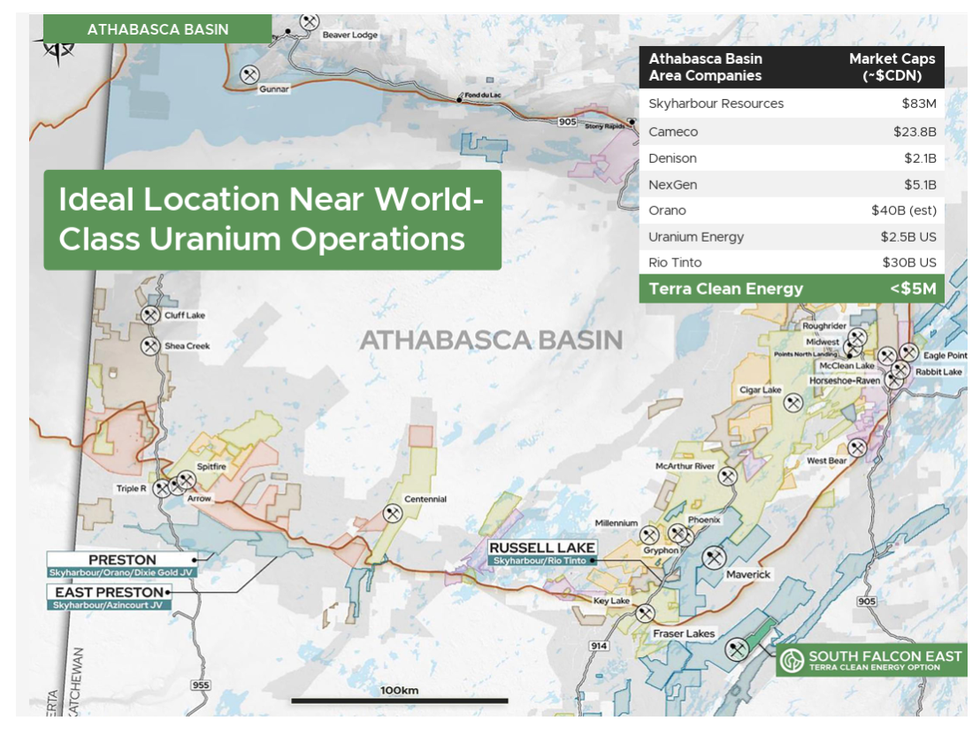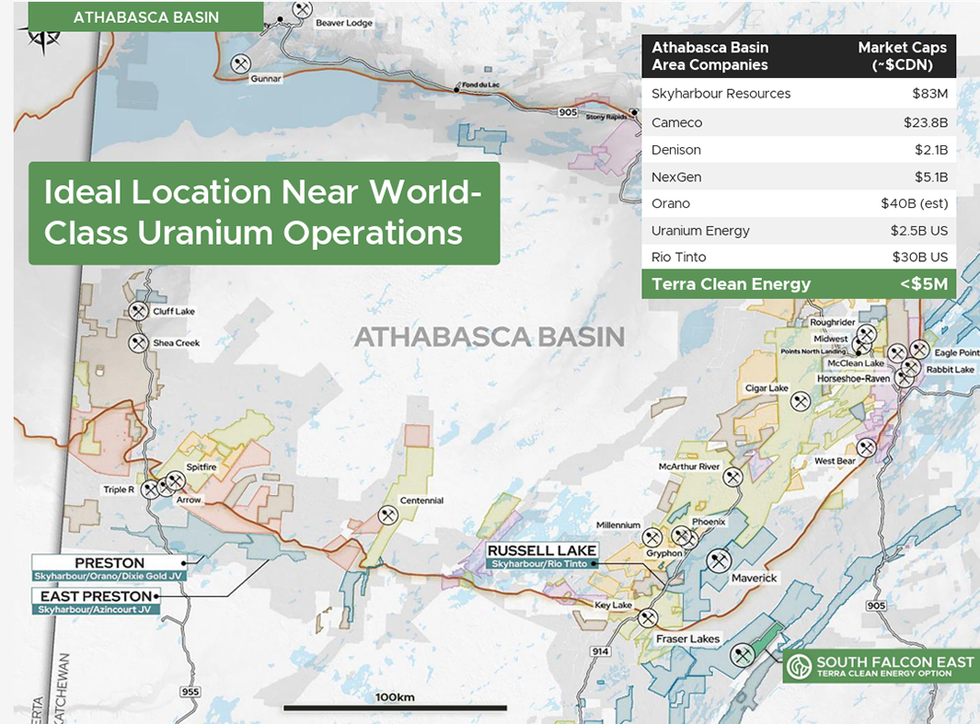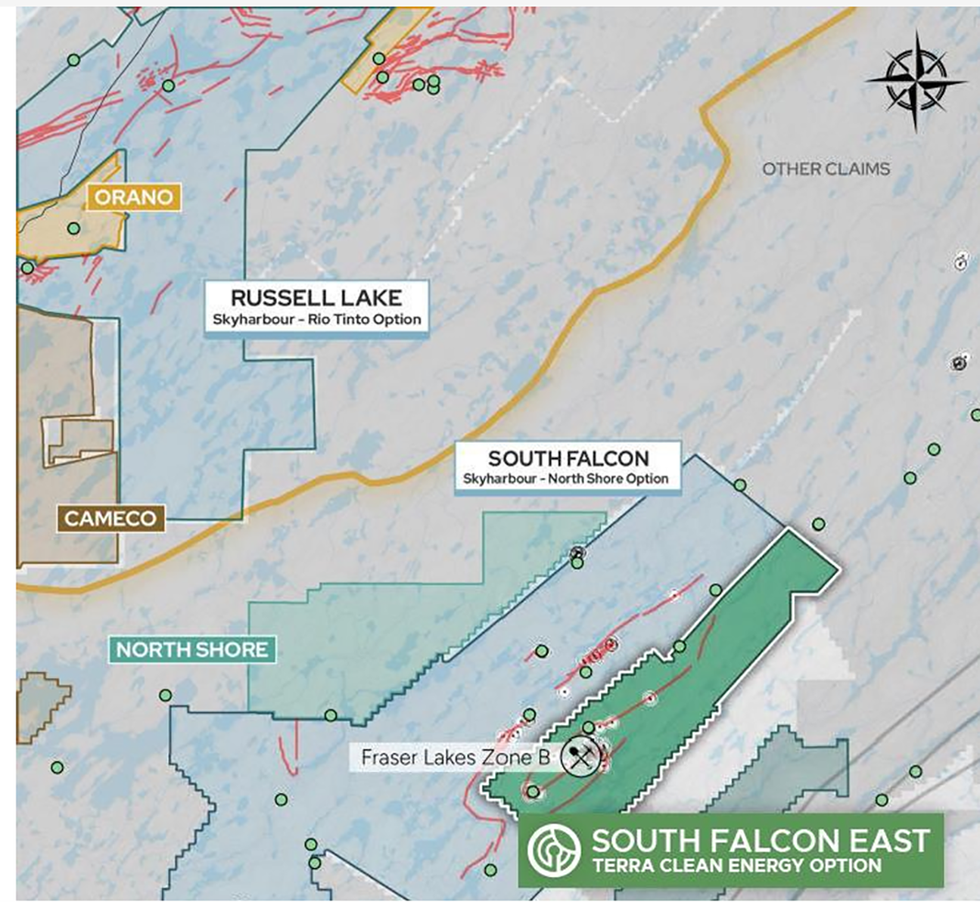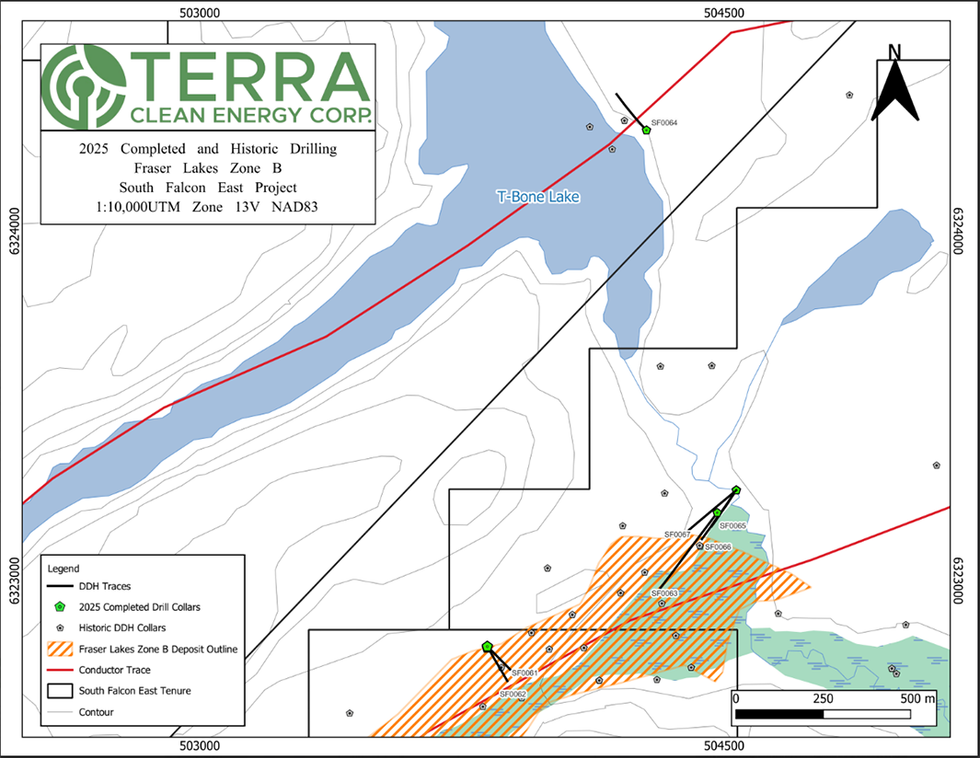Denison Mines Corp. ("Denison" or the "Company") (TSX: DML) (NYSE American: DNN) is pleased to report the discovery of new high-grade unconformity-hosted uranium mineralization from the winter 2021 exploration program completed at the Company's 22.5% owned McClean Lake Joint Venture ("McClean Lake" or "MLJV"). Three of the final four drill holes completed by Orano Canada Inc. ("Orano Canada"), 77.5% owner and operator of the MLJV, returned uranium mineralization at the McClean South target area (see Figure 1), with the results highlighted by drill hole MCS-34, which returned 5.04% eU 3 O 8 over 14.0 metres (including 14.86% eU 3 O 8 over 3.9 metres). View PDF version
Andy Yackulic , P. Geo., Denison's Director, Exploration, commented, "The latest results from McClean South are quite exciting. Not only has drilling intersected very high-grade uranium, but the mineralization is open along strike to the west for at least 250 metres and approximately 70 metres to the east towards the McClean South 8E pod. The mineralized intersection in MCS-34 represents one of the better mineralized intersections reported on the McClean Lake property to date – which is impressive, as the property has been explored since the mid-1970s and has previously produced over 50 million pounds U 3 O 8 ."
David Cates , Denison's President & CEO, added "The discovery of new high-grade uranium mineralization at McClean South reminds us of the significant potential associated with Denison's portfolio of development and exploration interests in the Athabasca Basin. Orano Canada is a world-class business partner and the operator of Denison's 22.5% owned McClean Lake uranium mill. With excess licensed capacity at the McClean Lake mill, any meaningful new uranium discovery on the McClean Lake property has the potential to translate into an important source of future mill feed and ultimately considerable value for the MLJV and its owners."
2021 McClean Lake Exploration Highlights
A diamond drilling program consisting of 15 drill holes totalling 4,083 metres was recently completed at McClean Lake. The 2021 exploration program was designed to test for the potential expansion of previously discovered mineralization in the McClean South 8W and 8E pods, as well as to test for new mineralization in the surrounding area (see Figure 2).
Drill hole MCS-34 was designed to test a potentially significant gap in drilling west of the McClean South 8E pod, where historical drilling was believed to have tested too far to the north of the optimal target area. Drill hole MCS-34, which was drilled at an azimuth of 345° and a dip of -60°, targeted the extension of the McClean South conductor approximately 120 metres west of the McClean South 8E pod and successfully intersected high-grade unconformity-associated uranium mineralization at an approximate depth of 182 metres – returning a mineralized interval of 5.04% eU 3 O 8 over 14.0 metres (including 14.86% eU 3 O 8 over 3.9 metres). Due to deteriorating surface conditions, owing to warming weather towards the end of the exploration program, follow-up of this result on section was not possible.
Follow-up efforts were targeted along strike to the east of MCS-34, including drill hole MCS-36, which was designed to test the extent of the mineralization encountered in MCS-34 at the unconformity approximately 15 metres to the east. Drill hole MCS-36, which was drilled at an azimuth of 345° and a dip of -70°, intersected uranium mineralization hosted within a fault zone in the basal sandstone, returning a mineralized interval grading 1.17% eU 3 O 8 over 3.1 metres . Further follow up occurred approximately 10 metres to the north of MCS-36, with the completion of drill hole MCS-37, which was drilled at an azimuth of 345° and a dip of -67.5°, and also intersected uranium mineralization beginning approximately 19 metres above the unconformity contact, returning 0.52% eU 3 O 8 over 6.4 metres .
Taken together, three of the final four drill holes completed at the McClean South target area returned notable uranium mineralization in the area west of the McClean South 8E pod, which has few previous drill holes. Follow-up drilling is warranted in this area and is expected to be planned by the MLJV for the winter of 2022. Additionally, two other drill holes completed at the McClean South target area during the winter program returned uranium mineralization, as outlined in the summary table and further detailed below.
Table 1 – 2021 McLean Lake Exploration Drilling - Mineralized Intersections
| Hole-ID | From (m) | To (m) | Length (m) | eU 3 O 8 (%) (1) |
| MCS-26 (2) | 221.7 | 222.6 | 0.9 (3) | 0.08 |
| MCS-31 (2) | 224.5 | 225.6 | 1.1 (4) | 0.14 |
| MCS-34 (2) | 182.8 | 196.8 | 14.0 (5) | 5.04 |
| Including (6) | 192.3 | 196.2 | 3.9 (5) | 14.87 |
| MCS-36 (2) | 165.4 | 168.5 | 3.1 (7) | 1.17 |
| MCS-37 (2) | 164.3 | 170.7 | 6.4 (7) | 0.52 |
| Notes: | (1) Radiometric equivalent U 3 O 8 ("eU 3 O 8 ") derived from a calibrated gamma downhole probe |
| | (2) Intersection interval is composited above a cut-off grade of 0.05% eU 3 O 8 |
| | (3) True thickness is estimated to be approximately 40% of stated downhole length |
| | (4) True thickness is estimated to be approximately 65% of stated downhole length |
| | (5) True thickness is estimated to be approximately 85% of stated downhole length. |
| | (6) Intersection interval is composited above a cut-off grade of 1.0% eU 3 O 8 |
| | (7) True thickness is estimated to be approximately 90% of stated downhole length. |
Drill hole MCS-26, was designed to test the up-dip extension of basement mineralization discovered in historical drill hole MCS-13 at the unconformity. The hole was collared approximately 12.5 metres north of MCS-13 and drilled at an azimuth of 345° and a dip of -78°. MCS-26 intersected low-grade mineralization approximately 49 metres below the unconformity, coincident with the basal contact of an anatectic granite.
Drill hole MCS-31, drilled at an azimuth of 345° and a dip of -80°, was designed to test the 120 metre gap between historical drill fences immediately east of the McClean South 8E pod on Line 835E of the 2005 McClean South EM survey grid. Low-grade mineralization was intersected in the basement, approximately 50 metres below the unconformity contact, associated with a redox front located along the basal contact of a graphitic pelite.
Radiometric Equivalent Grades, Sampling, Analysis and Data Verification
Following the completion of a drill hole, the hole is radiometrically logged using a downhole slimline gamma probe, which collects continuous readings of radioactivity along the length of the drill hole. Probe results are then calibrated using an algorithm calculated from the comparison of probe results against geochemical analyses in the area. The gamma-log results provide an immediate radiometric equivalent uranium value (eU%, then converted to eU 3 O 8 %) for the hole, which, except in very high grade zones, is reasonably accurate. The Company typically reports eU 3 O 8 , as a preliminary result and subsequently reports definitive assay grades following sampling and chemical analysis of the mineralized drill core.
Assay sample intervals are generally 50 centimetres long, except where higher or lower grade mineralization boundaries fall within the interval. In that case, two 25 centimetre samples are collected. Flank samples of 1.0 metre are always collected where mineralization is located. Systematic geochemistry samples are collected every 10 metres down the hole.
All assayed core is split in half, with one half retained and the other sent to the SRC Geoanalytical Laboratory in Saskatoon for analysis. Control samples are routinely assayed with each batch of core samples analyzed.
For results from McClean Lake, Orano Canada has performed detailed QAQC and data verification, where possible, of all datasets. Denison has performed additional QAQC and data verification of the drilling database including review of the QAQC methods and review of downhole probe and eU calculation procedures.
McClean South 8E and 8W Pods
The McClean South trend is located parallel to and approximately 500 metres south of the McClean North trend in the southwestern portion of the property (see Figure 1). The McClean South target area has been the subject of historic exploration drilling, resulting in the discovery and subsequent delineation of the 8W and 8E pods, which are situated along a N70° to 80° trend in close proximity to the McClean Lake granitic dome to the south (see Figure 2). The dip of the geology appears to range from 45° to 65° S in the 8W pod. In contrast, the dip within the 8E pod is steeper and undulating but is most commonly around 80° S. Several graphitic horizons of varying thickness are present in the McClean South target area and extend beyond and into other parts of the property.
Mineralization within the 8W pod is currently understood to be primarily hosted within the sandstone; however, it has also been locally encountered within the basement of the 8W pod. The mineralization within the sandstone can extend upwards of 50 metres above the unconformity. Mineralization within the 8E pod is currently understood to overlap the unconformity, with mineralization located both in the sandstone and and within the upper basement. The 8W pod is approximately 260 metres long, and the 8E pod is approximately 310 metres long. The maximum width of the pods is 50 metres, and the maximum thickness of the pods is as much as 100 metres.
No current resource estimate, prepared in accordance with NI 43-101, exists for the mineralization identified to date at the McClean South pods.
About McClean Lake
The McClean Lake property is located on the eastern edge of the Athabasca Basin in northern Saskatchewan , approximately 750 kilometres north of Saskatoon . Denison holds a 22.5% ownership interest in the MLJV and the McClean Lake uranium mill, one of the world's largest uranium processing facilities. The mill has licensed annual production capacity of 24.0 million pounds U 3 O 8 , and is currently operating under a 10-year license expiring in 2027. The mill is contracted to process the ore from the Cigar Lake mine under a toll milling agreement (up to 18.0 million pounds U 3 O 8 per year). The MLJV is an unincorporated contractual arrangement between Orano Canada with a 77.5% interest and Denison with a 22.5% interest. Orano Canada is the operator of the project.
McClean Lake consists of nine known uranium deposits: JEB; Sue A, B, C, D and E; McClean North; McClean South; and Caribou. In 1995, the development of the McClean Lake project began. Mill construction commenced in 1995 and ore processing activities reached commercial production in November 1999. Mining operations commenced in 1996 and the following deposits have been mined out to date: JEB (1996 to 1997), Sue C (1997 to 2002), Sue A (2005 to 2006), Sue E (2005 to 2008) and Sue B (2007 to 2008).
About Denison
Denison is a uranium exploration and development company with interests focused in the Athabasca Basin region of northern Saskatchewan, Canada . The Company's flagship project is the 90% owned Wheeler River Uranium Project, which is the largest undeveloped uranium project in the infrastructure rich eastern portion of the Athabasca Basin region of northern Saskatchewan . In addition to Denison's interests in the MLJV, Denison's interests in Saskatchewan include a 25.17% interest in the Midwest Main and Midwest A deposits, and a 66.90% interest in the Tthe Heldeth Túé ("THT," formerly J Zone) and Huskie deposits on the Waterbury Lake property. Each of Midwest Main, Midwest A, THT and Huskie are located within 20 kilometres of the McClean Lake mill.
Denison is engaged in mine decommissioning and environmental services through its Closed Mines group (formerly Denison Environmental Services), which manages Denison's Elliot Lake reclamation projects and provides post-closure mine care and maintenance services to a variety of industry and government clients.
Denison is also the manager of Uranium Participation Corp., a publicly traded company which invests in uranium oxide and uranium hexafluoride.
Qualified Persons
The technical information contained in this release has been reviewed and approved by Mr. Andrew Yackulic , P. Geo., Denison's Director, Exploration, who is a Qualified Person in accordance with the requirements of NI 43-101.
Cautionary Statement Regarding Forward-Looking Statements
Certain information contained in this news release constitutes 'forward-looking information', within the meaning of the applicable United States and Canadian legislation concerning the business, operations and financial performance and condition of Denison.
Generally, these forward-looking statements can be identified by the use of forward-looking terminology such as 'plans', 'expects', 'budget', 'scheduled', 'estimates', 'forecasts', 'intends', 'anticipates', or 'believes', or the negatives and/or variations of such words and phrases, or state that certain actions, events or results 'may', 'could', 'would', 'might' or 'will be taken', 'occur', 'be achieved' or 'has the potential to'.
In particular, this news release contains forward-looking information pertaining: the interpretation of the results from the McClean South exploration program undertaken by Orano Canada, underlying assumptions and the MLJV's intentions with respect thereto;; exploration plans and objectives; and expectations regarding its joint venture ownership interests and the continuity of its agreements with its partners.
Forward looking statements are based on the opinions and estimates of management as of the date such statements are made, and they are subject to known and unknown risks, uncertainties and other factors that may cause the actual results, level of activity, performance or achievements of Denison to be materially different from those expressed or implied by such forward-looking statements. For example, Denison is relying on the information provided, and the procedures undertaken, by the operator of the MLJV and its ability to oversee the exploration results disclosed herein is different than for Denison-operated projects; areas of interest for further exploration selected based on interpretation of current and historic exploration may not result in findings of significance after further testing; the results and interpretations of historic exploration and mineralization may not be maintained after further testing and analysis; and results of exploration reported as radiometric equivalent grades are preliminary in nature and may not be maintained after further sampling and chemical analysis; and the MLJV or the operator thereof may not complete any further exploration or testing related to these exploration results, over which Denison has limited control. Denison believes that the expectations reflected in this forward-looking information are reasonable but no assurance can be given that these expectations will prove to be accurate and results may differ materially from those anticipated in this forward-looking information. For a discussion in respect of risks and other factors that could influence forward-looking events, please refer to the factors discussed in Denison's Annual Information Form dated March 29, 2021 under the heading 'Risk Factors'. These factors are not, and should not be construed as being exhaustive.
Accordingly, readers should not place undue reliance on forward-looking statements. The forward-looking information contained in this news release is expressly qualified by this cautionary statement. Any forward-looking information and the assumptions made with respect thereto speaks only as of the date of this news release. Denison does not undertake any obligation to publicly update or revise any forward-looking information after the date of this news release to conform such information to actual results or to changes in Denison's expectations except as otherwise required by applicable legislation.
Cautionary Note to United States Investors Concerning Estimates of Mineral Resources and Mineral Reserves: This presentation may use terms such as "measured", "indicated" and/or "inferred" mineral resources and "proven" or "probable" mineral reserves, which are terms defined with reference to the guidelines set out in the Canadian Institute of Mining, Metallurgy and Petroleum ("CIM") CIM Definition Standards on Mineral Resources and Mineral Reserves ("CIM Standards"). The Company's descriptions of its projects using CIM Standards may not be comparable to similar information made public by U.S. companies subject to the reporting and disclosure requirements under the United States federal securities laws and the rules and regulations thereunder.
This press release contains information relating to third parties derived from third-party publications and/or reports which Denison believes are reliable but have not been independently verified by the Company.
Figure 1 - McClean Lake Project Claims
Figure 2 - McLean Lake South - 2021 Drilling
![]() View original content to download multimedia: https://www.prnewswire.com/news-releases/denison-announces-discovery-of-high-grade-uranium-mineralization-at-mcclean-lake-south-301268471.html
View original content to download multimedia: https://www.prnewswire.com/news-releases/denison-announces-discovery-of-high-grade-uranium-mineralization-at-mcclean-lake-south-301268471.html
SOURCE Denison Mines Corp.
















